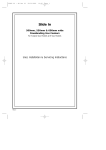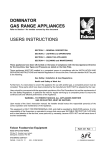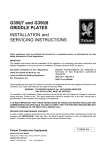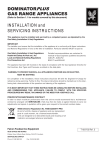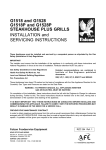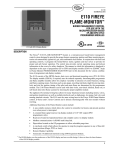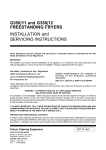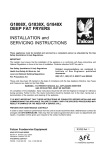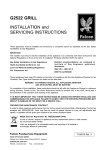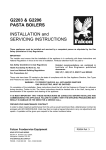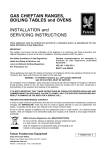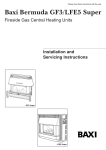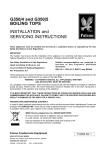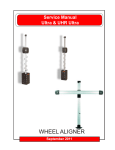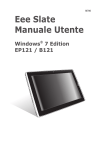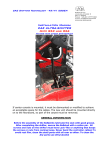Download Service Manual - AS Catering Supplies
Transcript
DOMINATOR GAS RANGE APPLIANCES Refer to Section 1.1 for the models covered by this document INSTALLATION and SERVICING INSTRUCTIONS These appliances must be installed and serviced by a competent person as stipulated by the Gas Safety (Installation & Use) Regulations. IMPORTANT The installer must ensure that the installation of the appliance is in conformity with these instructions and National Regulations in force at the time of installation. Particular attention MUST be paid to Gas Safety (Installation & Use) Regulations Health And Safety At Work etc. Act Local and National Building Regulations Fire Precautions Act Detailed recommendations are contained in Institute of Gas Engineers published documents : IGE/ UP/ 1, IGE/ UP/ 2, BS6173 and BS5440 These appliances have been CE-marked on the basis of compliance with the Gas Appliance Directive for the Countries, Gas Types and Pressures as stated on the Data Plate. WARNING - TO PREVENT SHOCKS, ALL APPLIANCES WHETHER GAS OR ELECTRIC, MUST BE EARTHED. On completion of the installation, these instructions should be left with the Engineer-in-Charge for reference during servicing. Further to this, The Users Instructions should be handed over to the User, having had a demonstration of the operation and cleaning of the Appliance. IT IS MOST IMPORTANT THAT THESE INSTRUCTIONS BE CONSULTED BEFORE INSTALLING AND COMMISSIONING THIS APPLIANCE. FAILURE TO COMPLY WITH THE SPECIFIED PROCEDURES MAY RESULT IN DAMAGE OR THE NEED FOR A SERVICE CALL. PREVENTATIVE MAINTENANCE CONTRACT In order to obtain maximum performance from this unit we would recommend that a Maintenance Contract be arranged with AFE SERVICELINE. Visits may then be made at agreed intervals to carry out adjustments and repairs. A quotation will be given upon request to the contact numbers below. Falcon Foodservice Equipment HEAD OFFICE AND WORKS PO Box 37, Foundry Loan, Larbert. Stirlingshire. Scotland. FK5 4PL AFE SERVICE CONTACT PHONE - 01438 751111 FAX - 01438 369900 RZZ 331 Ref. 1 SECTION 1 - INSTALLATION UNLESS OTHERWISE STATED, PARTS WHICH HAVE BEEN PROTECTED BY THE MANUFACTURER ARE NOT TO BE ADJUSTED BY THE INSTALLER. 1.1 MODEL NUMBERS, NETT WEIGHTS and DIMENSIONS DEPTH HEIGHT WEIGHT MODEL WIDTH mm mm mm kg G2101/07 OPEN TOP RANGES G2107 SOLID TOP RANGE G2121 OPEN TOP B. Table G2127 SOLID TOP B. Table G2117 OVEN on Stand G2117 OVEN with Worktop G2117/2 Two tier oven G2161/67 OPEN TOP RANGES G2124 OPEN TOP B. Table 900 770 870 129 900 770 870 147 900 770 870 70 900 770 870 88 900 770 1470 129 900 770 900 770 1700 195 600 770 870 88 600 770 870 50 870 97 1.2 SITING The appliance should be installed on a level, fireproof surface, in a well lit and draught free position. Should the floor be of combustible material, then local fire requirements should be checked to ensure compliance. A clear space of 150mm should be left between the back of the appliance and any combustible wall. There should be a minimum vertical clearance of 1220mm above the top edge of the range and boiling table flues and 450mm above the oven flues. Important If the appliance is to be installed in suite formation with other matching appliances, the instructions for all models must be consulted to determine the necessary clearances to any combustible rear wall or overlying surface. Some appliances require greater clearances than others, and the largest figure quoted in the individual instructions will therefore determine the clearance of the complete suite adjoining appliances. The appliance flue discharges vertically from the top of the unit. It must not be directly connected to any flue, mechanical extraction system , or ducting etc, leading to outside the building. The appliance is best discharged under an open canopy which connects with a ventilating system. 1.3 VENTILATION Adequate ventilation, whether natural or mechanical, must be provided to supply sufficient fresh air for combustion and allow easy removal of combustion products which may be harmful to health. Recommendations for Ventilation of Catering Appliances are given in BS5440 : 2. Furthermore, to ensure sufficient room ventilation, guidance on the volume of ventilation air required for different types of catering equipment is provided in the table below. For multiple installations the requirements for individual appliances should be added together. Installation should be made in accordance with local and/ or national regulations applying at the time. A competent installer MUST be employed. EQUIPMENT Range, Unit Type Pastry Oven Fryer Grill Steak Grill Boiling Pan Steamer Sterilizing Sink Bains Marie Tea/ Coffee Machine Ventilation Rate Required m3/ min ft3/min 17 17 26 17 26 17 17 14 11 8.5 - 14 600 600 900 600 900 600 600 500 400 300 - 500 1.4 GAS SUPPLY The incoming service must be of sufficient size to supply full rate without excessive pressure drop. A gas meter is connected to the service pipe by the Gas Supplier. Any existing meter should be checked by the Gas Supplier to ensure that the meter is of adequate capacity to pass the required rate of the appliance in addition to any other gas equipment installed. Installation pipe work should be fitted in accordance with IGE/UP/2. The pipe work should not be smaller than the gas inlet connection on the appliance, ie. Rp3/4 (3/4" B.S.P.). An isolating cock must be located close to the appliance to allow shut-down during an emergency or servicing. The installation must be tested for gas soundness. details of this procedure can be found in IGE/UP/1. 1.5 ELECTRICAL SUPPLY Not applicable to these appliances. 1.6 WATER SUPPLY Not applicable on this appliance 1.7 HEAT INPUTS - NATURAL and PROPANE GAS (kW net & Btu/hr gross) 1.7.1 Total Inputs Model G2101 OT G2107 OT G2107 SB G2121 OT G2127 SB G2117 Oven G2161 OT G2167 OT G2124 OT kW 35.7 34.1 17.3 28.6 10.2 7.1 23.6 22.8 18.8 Btu/hr 134,000 128,000 65,000 107,000 38,500 26,500 88,500 85,500 70,500 1.7.2 Individual Inputs (kW net & Btu/hr gross) Model Open Top (Std) Open Top (Boost) Solid Top 900mm Ovens 600mm Ovens kW 4.5 5.3 10.2 7.1 4.8 Btu/hr 16,000 20,000 38,500 26,500 18,000 1.8 INJECTOR DIAMETERS NATURAL and PROPANE GAS Model Open Top (Std) Open Top (Boost) Solid Top Solid Top (Pilot) 900mm Oven 600mm Oven Natural Propane é1.75mm é1.07mm é1.95mm é1.2mm é2.65mm A360 SIT 36 SIT 19 é2.3mm A250 é1.8mm A170 1.9 GAS PRESSURE ADJUSTMENT NATURAL and PROPANE GAS The following supply pressures apply to all units :Gas Type Natural Propane mbar 20 37 inches w.g. 8 14.8 Pressure test point is located on RH side of gas manifold situated behind front control facia. An adjustable governor (3/4" BSP) is provided on Natural Gas units.This should be adjusted to achieve an operating pressure at the control manifold of 15mbar (6 inches w.g.). For multi-burner systems, approximately half of the burners should be on when setting governor pressure. 1.10 BURNER ADJUSTMENT NATURAL and PROPANE GAS 1.10.1 Burner Aeration Open top hob burners are fitted with fixed injectors and set aeration apertures. NO ADJUSTMENT is possible. Solid top and oven burners have fixed injectors and aeration shroud. Adjustment required (see Figure 1). Model Solid Top 900mm Oven 600mm Oven Natural mm 0mm Fully Open 4mm Propane mm 0mm Fully Open 6mm Figure 1 X Solid Top Burner X Oven Burner 1.10.2 Bypass Screw Diameters Minimum gas flow to burner is governed by the size of the fixed by-pass screw hole as follows:Model Open Top 900mm Oven 600mm Oven Natural émm 0.84 0.85 0.75 Propane émm 0.5 0.55 0.45 Minimum glas flow for solid top is set by adjustment. Connect a manometer to the burner pressure test point on the injector block. Gas Type Natural Propane mbar 2 5 inches w.g. 0.8 2 SECTION 2 - ASSEMBLY and COMMISSIONING 2.1 ASSEMBLY 2.1.1 Assembly of Ranges and GP Ovens Note The following paragraphs should be read as applicable to the unit being assembled. a) Unpack appliance and place unit in position using the feet adjusters to level appliance. b) Open oven door , pull out shelves and loose base panel. Check burner spark igniter arrangements are correctly located and secured. Ensure ALL packing, etc. is removed from oven. Replace all parts in reverse sequence. c) Check solid top by removing bullseye, ring and filling plates. Ensure burner is located correctly upon both the injector and support strap. Remove any loose packing and replace fillings etc. d) Check open top - remove tape, packing, etc. from hob area and ensure that all burners and pan supports are secured in position. Burner head fits loosely on to aluminium bezels which are a lift-off construction. 2.2 CONNECTION TO GAS SUPPLY Connect appliance to gas supply and ensure that a governor is fitted on NATURAL gas installations. Test for gas soundness. The integral gas supply downstream of gas valve may be checked by applying leak detection spray with burner lit. Appliance inlet connection terminates at upper rear RH side in Rp3/4 (3/4" BSP female). 2.3 CONNECTION TO ELECTRICAL SUPPLY Not applicable to these appliances. 2.4 CONNECTION TO WATER SUPPLY Not applicable to these appliances. 2.5 COMMISSIONING THE APPLIANCE Important Prior to operation, ensure ALL packing material has been removed. 2.5.1 Setting The Gas Pressure a) It is necessary to check the gas pressure during commissioning and a suitable pressure gauge must be connected to pressure test point on RH side of gas supply manifold (situated behind front control facia). b) Now turn on main gas valve at supply to unit. c) Light approximately half of the burners on the unit as described in Section 2.5.3. As gas supply pipes may contain air, continue to repeat lighting procedure. d) Adjust gas pressure governor (NATURAL gas installations only) at unit rear to relevant pressure setting found in Section 1.9. To increase pressure turn the screw clockwise or anti-clockwise to decrease pressure. Check again after 15 minutes of operation. e) Disconnect pressure gauge from test point. Replace test point sealing screw and test for gas soundness. 2.5.2 Checking The Performance of the Controls a) Light open top, solid top or oven as detailed in Section 2.5.3. Check ignition is smooth and without delay. Repeat operation several times. b) Place a thermocouple in centre of oven and select 210o C on thermostat knob. Allow oven to heat up and check temperature is 210 +/- 7 o C. If temperature reading is outwith specified range, there may be a faulty thermostat, in which case the unit should be serviced (see thermostat replacement and calibration procedure). Turn OFF gas supply to oven and allow a sufficient cool down period before removing thermocouple. 2.5.3 Lighting Sequence Important Prior to operation, ensure ALL packing material has been removed from appliance. Open Top 1. Ensure mains gas is turned on. 2. To light hob burners, press knob and turn to full flame position. Ignite burners using taper or match. Hold in knob for 20 seconds and then release. burner will remain lit. Turn knob to required position. Oven 1. Ensure mains gas is turned on. 2. To light oven, open doors - press thermostat knob and turn to maximum. This will establish a flow of gas to oven burner. Press piezo igniter button, (situated in recess below oven doors) to provide a spark at the burner. 3. Having lit the burner, continue to press thermostat knob for a further 20 seconds before release. Check burner remains lit and turn thermostat to required setting. 4. To extinguish oven flame, turn thermostat to OFF position. Solid Top 1. Ensure mains gas is turned on. 2. Remove bullseye castings from solid top hob. 3. Push control knob in and turn anti-clockwise to ignition position. 4. Holding control knob in fully, apply a taper to pilot and observe that pilot lights. 5. When pilot is lit, continue to hold knob fully in for 20 seconds before release. If pilot is extinguished, wait 3 minutes and repeat from Step 3. 6. Having established pilot condition, turn control knob anti-clockwise to FULL FLAME position to light burner. 7. For LOW FLAME operation, turn control knob further anti-clockwise to LOW FLAME position. Check burner pressure as detailed in Section 1.10.2. 8. Replace bullseye castings. 2.6 INSTRUCTION TO USER Whenever possible, the installer should ensure that the user thoroughly understands the instructions for lighting, cleaning and correct use of the appliance. This is particularly important when FLAME FAILURE DEVICES are fitted. It is also important to ensure that the location of the gas isolating cock is made known to the user, and that the procedure in an emergency is demonstrated. SECTION 3 - SERVICING AND CONVERSION Important BEFORE ATTEMPTING ANY SERVICING, ENSURE ISOLATING COCK IS TURNED OFF AND CANNOT BE INADVERTANLY TURNED ON. AFTER ANY MAINTENANCE TASK, CHECK APPLIANCE TO ENSURE THAT IT PERFORMS CORRECTLY AND CARRY OUT ANY NECESSARY ADJUSTMENTS AS DETAILED IN SECTION 1. After carrying out any servicing or exchange of gas carrying components ALWAYS CHECK FOR GAS SOUNDNESS! 3.1 GAS CONVERSION CHECK LIST For conversion to NATURAL GAS, add correct governor and set burner pressure. For conversion to PROPANE GAS, remove governor from gas circuit. Other considerations CHANGE INJECTORS CHANGE BY-PASS SCREW AND SET LOW RATE CHANGE BURNER AERATION SETTING. Refer to Section 1.10. CHANGE DATA PLATE 3.2 REMOVAL OF CONTROL PANELS Various panels are removed as follows:3.2.1 To Remove Facia Panel Remove control knobs. Undo fixings along underside and top. Pull facia panel forward while slightly easing bottom edge upward to remove. 3.2.2 To Access Oven Controls Open oven door, remove shelves and base plate. 3.2.3 To Remove Open Top Hob Remove pan supports and brass burner heads which sit loosely upon the burner venturies. For models with a semi-sealed hob, the hob is retained by a ballstud. Lift hob clear to access burner support bracket. For models with drip sheds, remove these by undoing the fixings which retain them to the hob structure. 3.2.4 To Remove Worktop Remove fixings which secure front hob support and those which secure flue to back panel. Lift full hob area including the flue, clear of unit. 3.3 BURNERS 3.3.1 Open Top Remove hob components as Section 3.2.3. Undo burner pipe compression fitting. Remove brass securing nut on burner support. Take care not to deform it, the top surface must remain flat. Withdraw burner body. Replace in reverse order. 3.3.2 Oven Open oven doors and remove base panel. Undo lock-nut on oven injector and remove the fixings from injector support bracket. Undo injector from gas supply pipe and gently lift oven burner to remove injector. Replace in reverse order. 3.3.3 Solid Top Remove hotplate castings and combustion box. Undo fixings which secure burner to support channel and withdraw burner. 3.3.4 Solid Top Pilot Assembly Remove hotplate castings and burner tray. Undo thermocouple retaining nut at pilot assembly. Undo and disconnect pilot pipe at pilot assembly. Remove fixings which secure pilot assembly to mounting bracket. Remove pilot assembly. Replace in reverse order. 3.3.5 Cleaning Burners should be cleaned periodically to maintain maximum performance. Burners are best cleaned with a wire brush; ports being freed from blockage with a metal broach , any loose material being shaken out via the burner shank. 3.4 INJECTORS 3.4.1 Open Top Remove burner as detailed in Section 3.3.1. Undo and carefully remove injector. Replace in reverse order. 3.4.2 Oven Remove burner as detailed in Section 3.3.2. Undo injector and remove. Replace in reverse order. 3.4.3 Solid Top Remove burner as detailed in Section 3.3.3. Undo injector and remove. Replace in reverse order. 3.4.4 Solid Top Pilot Injector Remove hotplate castings and burner tray. Undo and disconnect pilot pipe at pilot assembly. Remove pilot injector. Replace in reverse order. 3.4.5 Cleaning Injectors are best cleaned with a wooden splinter or soft fuse wire. Metal reamers may distort or increase orifice size and their use should be avoided. Ensure burners are dry and free from any cleaning material before replacing. Check adjustment as in Section 1. 3.5 THERMOCOUPLES and FLAME FAILURE DEVICE (FFD) 3.5.1 Open Top Flame Failure Device Magnet Unit All open top burners are protected by FFD, they are also fitted with thermocouple(s). To remove and replace FFD Magnet Unit, the following procedures must be followed. Remove Gas Tap (see Section 3.8) Having removed gas tap, undo FFD section at tap rear and withdraw. Repeat for all hob burners. Replace in reverse order. 3.5.2 Open Top Thermocouple Remove facia panel as detailed in Section 3.2.1. Remove hob pan supports and burner heads as detailed in Section 3.2.3. Burner support bracket is situated directly below hob well. Remove nut which secures thermocouple to burner support bracket and pull thermocouple through support bracket from underside. Undo thermocouple connection at FFD section of gas tap and carefully remove thermocouple. Replace in reverse order. 3.5.3 Oven Flame Failure Device Magnet Unit The oven FFD magnet unit is an integral thermostat part. Remove thermostat to gain access to FFD. For removal details refer to relevant part of Section 3.7 Having removed thermostat, undo rear FFD section and withdraw. Replace in reverse order. 3.5.4 Oven Thermocouple Oven thermocouple is split-type which consists of a thermocouple sensor and extension. To Remove Thermocouple Extension Remove facia panel end as detailed in Section 3.2.1. Remove hob fitments. See Sections 3.2.3, 3.3.3 or 3.2.4 as required. Remove RH side panel. Undo thermocouple extension nut at thermostat rear. Open oven doors, remove shelves and baseplate. Undo split nut and remove thermocouple. Replace in reverse order taking care not to overtighten. To Remove Thermocouple Sensor Open over doors. remove shelves and base plate. Undo locknuts which secure thermocouple to burner bracket. Undo split-nut and remove thermocouple. Replace in reverse order and take care not to overtighten. 3.5.5 Solid Top Flame Failure Device Magnet Unit The solid top FFD magnet unit is an integral part of the gas tap. Remove gas tap in order to gain access to FFD, see Section 3.8. Having removed tap, undo rear FFD section and withdraw. Replace in reverse order. 3.5.6 Solid Top Thermocouple Remove hotplate castings, burner and combustion chamber box. Loosen fixings and remove heat shield panel behind controls. Undo nuts which secure thermocouple to FFD and pilot assembly. Withdraw thermocouple. Replace in reverse order. 3.6 OVEN IGNITERS and ELECTRODES Igniter is piezo spark type and contains no batteries. Unit comprises piezo, housing, lead and electrode assembly. Lead is push-fit at piezo and electrode ends. Oven igniter electrode, earth pin and burner ports should be aligned as indicated in Figure 2. 3.6.1 Oven Igniter To remove igniter, open doors and remove oven shelves and base plate. Remove spark igniter cover and pull off igniter lead. Undo nut which secures igniter in position. Remove Igniter. Replace in reverse order. 2.5mm 1mm Burner ports Outline of burner 5mm 3.5mm Figure 2 Ignition electrode 3.6.2 Oven Electrode Remove oven shelves and base plate. Disconnect igniter lead from electrode. Undo fixing securing electrode to burner bracket. Remove electrode and replace in reverse order ensuring position is as indicated in Figure 2. Note Care should be taken not to damage the electrode. 3.7 OVEN THERMOSTAT Remove control knobs and facia panel as detailed in Section 3.2.1. Remove hob fitments as detailed in Sections 3.2.3, 3.3.3 or 3.2.4 as appropriate. Undo thermocouple connection at thermostat rear. Disconnect the oven burner pipe. From inside the oven, release the clips which secure thermostat capillary to oven side wall. Undo fixings which secure thermostat to manifold. Remove thermostat by carefully feeding capillary and phial through crown plate. Replace all parts in reverse order. Renew gasket if necessary. 3.7.2 Thermostat Calibration The thermostat should not be calibrated. If temperature is outwith specified tolerances then replace thermostat and return faulty stat to the Falcon Quality Department. 3.8 GAS TAPS Open and Solid Top Taps 3.8.1 Service Remove control knobs and facia panel as detailed in Section 3.2.1. Remove fixings from front of tap body. Withdraw spindle and niting arrangement to allow plug to be eased out. Earth pin Thermocouple Clean gas tap plug with a soft rag and regrease using an approved high temperature lubricant taking care not to over grease as surplus may cause blockage in the gasways. Replace parts in correct order and check gas soundness. Note Plugs and bodies are machined in pairs and are, therefore, not interchangeable. Always clean one tap at a time. Replace in reverse order. 3.8.2 Removal Remove control knobs and facia panel as detailed in Section 3.2.1. Remove hob fitments as detailed in Sections 3.2.3 or 3.3.3 as appropriate. Disconnect thermocouple connection at gas tap rear. Disconnect burner supply pipe. Undo fixings which secure tap to manifold. Replace all parts in reverse order. Renew gasket if necessary. 3.9 GOVERNOR This applies to NATURAL GAS UNITS ONLY. The type of governor used will normally require little servicing. The air breather hole should be checked regularly for dirt blockage. Always re-check pressure at test point after governor maintenance. 3.10 FAULT CHECK LIST If a flame is not established on any burners (hob or oven), follow this check list 1. Check mains gas is ON. 2. Check pressure at pressure test point to ensure gas is flowing to the appliance. 3. If pressure does not register then check governor is fully operational or check for line blockage. 4. If gas is present then check burner injector for blockage. 5. If injector is OK then check FFD is engaging and passing gas. 6. Check for spark at spark electrode. 7. If there is no spark then check the spark gap and HT lead connections. Also check the igniter. 8. If a flame is still not present then re-check from start. If a flame is established but not maintained on the hob or oven burners, then follow this check list. 1. If a flame is present but not being maintained then check thermocouple is placed correctly in the burner flame. Burner ports must be clean. 2. Check also that thermocouple is not damaged and is securely fixed to gas valve FFD section to prevent the FFD from energising. 3. Check FFD is energising and maintaining flame. 4. If the above are OK then re-check from start. SECTION 4 - SPARES When ordering spare parts, always quote the appliance type and serial number. This information will be found on the data badge attached to the base plate. A list of parts available for this range of appliances can be found in the Spares section of this document pack.








